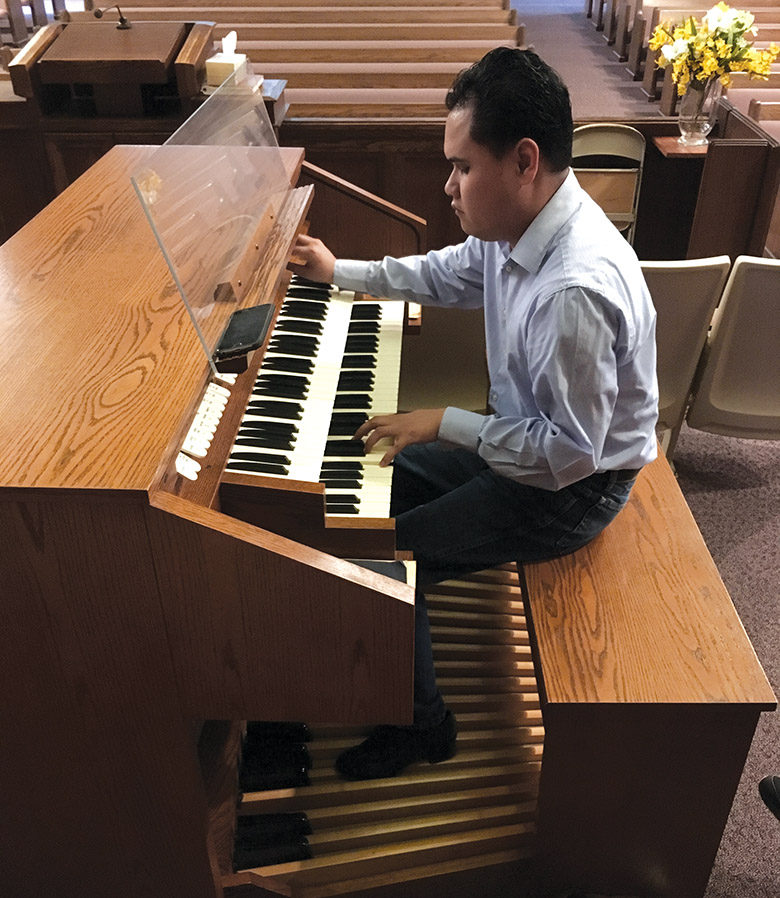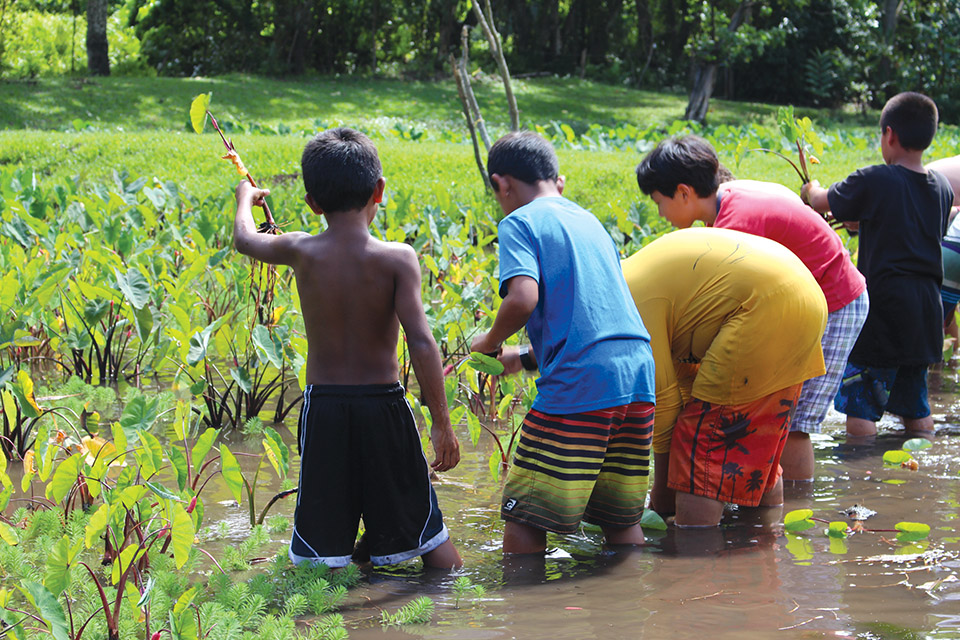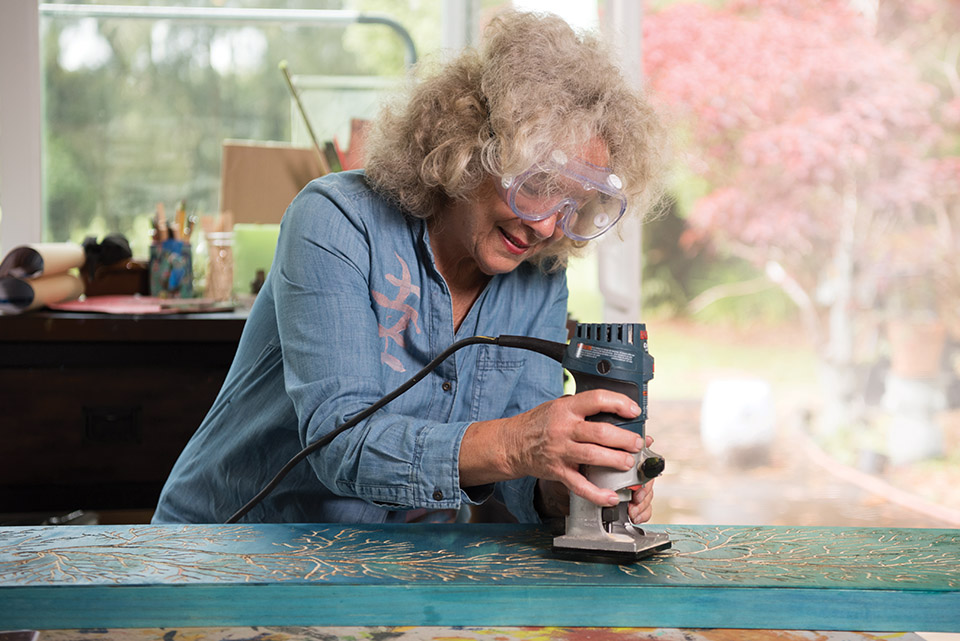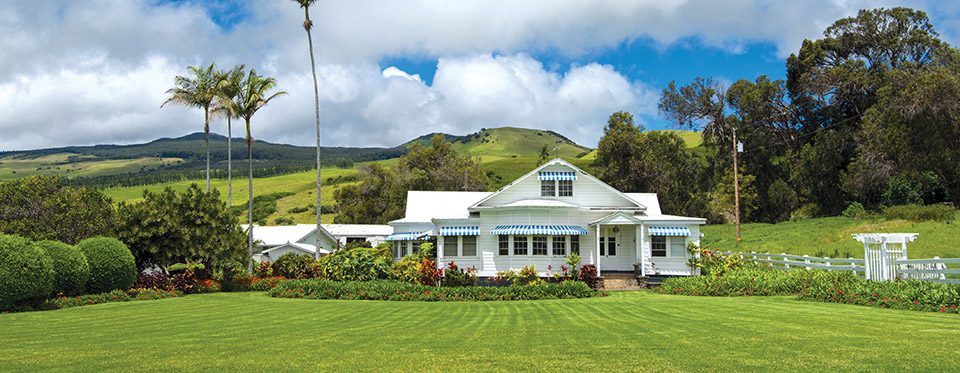
Anna Ranch: A Chapter of Waimea History

By Catherine Tarleton
Behind the white rail fence and trellis gate, across the lawn and gardens at the foot of Waimea’s rolling hills, inside the gracious white house with blue-striped awnings on its sunny bay windows, lives a story.
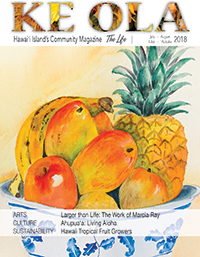
Opening the front door opens a chapter of Hawai‘i’s history. A chapter where strong, self-sufficient women like this story’s heroine, Anna Leialoha Lindsey Perry-Fiske, worked tirelessly, survived, prospered, took care of their lands and gave generously to support the community they loved.
The high-ceilinged parlor looks as if the lady of the house had just stepped out for a moment. Comfortable koa furniture is grouped around cowhide rugs; a hand-cranked music box for entertainment; paintings, photos, and an eland hunting trophy on the walls. Adjacent, a formal dining room with a long koa table waits beneath an oil portrait of “Aunty Anna” on horseback in full pā‘ū (horseback riders skirt) regalia. Hutches safeguard crystalware and Chinese porcelain treasures.
In the kitchen—now a gift shop—cupboards are neatly stacked with china in her favorite “Franciscan Rose” pattern. On top of the cabinets, a string of toy horses, corralled within a handmade fence. Five bedrooms—one of which was probably the original ranch cottage—each contain clothing, furnishings, art, and items from six generations.
Outside, walkways lead to outbuildings: a barn, slaughterhouse, carriage house-turned-garage. Beyond, above, on the slopes, cattle graze—descendants of Anna’s original herd of Charolais cattle.
Early Days
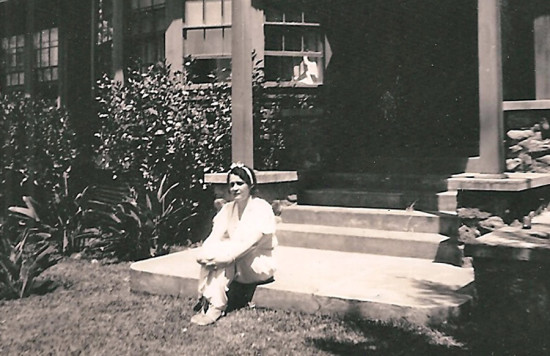
To tell the ranch’s story, we have to go back to the days before Anna was born, when her great-great-grandfather James Fay came to Hawai‘i from England in the early 19th century and married Ka‘ipukai‘ikapuokamehameha Kahahana, an ali‘i (royal) woman from O‘ahu.
James, who became known in the community—and in official records—as “Kimofe,” was given a parcel of land by Governor Kuakini for helping him with his cattle and various business interests. In those days, wild pipi (cattle) ran rampant on the countryside, before a concerted effort by island and paniolo (cowboys of Mexican descent) got them under control, beginning Hawai‘i’s ranching industry.
Kimofeʻs land parcel was named Wai‘au‘ia, which means “diverted water,” probably referring to the ancient ‘auwai (canal) irrigation system that can still be seen today. He and Ka‘ipukai made a home for themselves, and in 1830 they had a daughter, Mary Ka‘ala Fay.
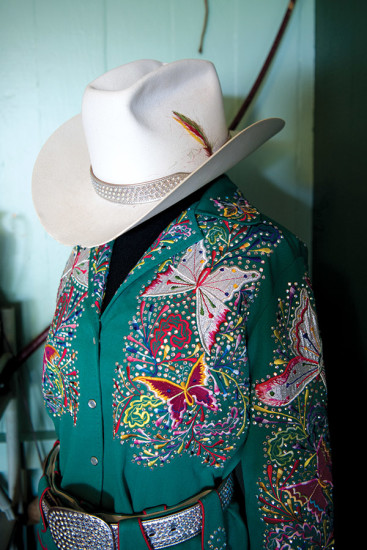
In 1848, Kimofe purchased a seven-acre plot called Keanu‘i‘omanō from a man named Mokuhia for $100. On the land were two old houses and a partially-built stone wall, often used by farmers to protect their homesteads from wild cattle. In 1850, Kimofe obtained an additional 180 acres in the Hanaipoe area of Hāmākua, built a sawmill and started milling koa wood. From that lumber, not only was his home constructed, but also some of Waimea’s most iconic buildings: Imiola Church, Mana (original home of Parker Ranch patriarch John Palmer Parker), and others.
Kimofe also transported lumber for export to the harbor at Kawaihae, a five-hour trip by bullock cart. Along with lumber, and his already-established business of cowhide and tallow, Kimofe had begun sheep ranching in Waimea. He and Ka‘ipukai kept a second residence at the present Anna Ranch site, where their children swam, and the family also washed their clothes in Wai‘au‘ia Stream.
Before he died in 1858, he sold Keanu‘i‘omano to son-in-law George Kynaston Lindsey for $300, and willed the remaining 1,000 acres to his daughter Mary. George passed his estate to Mary when he died, and she in turn left equal shares to her twelve children.
Their oldest son, Thomas Weston Lindsey, Anna’s grandfather, went on to become a well-known expert paniolo, and the cowboy foreman for Parker Ranch. A ranching native, he bought many of his siblings’ shares, developed the Lindsey Ranch, and amassed significant land holdings which he bequeathed in equal shares to his eight children.
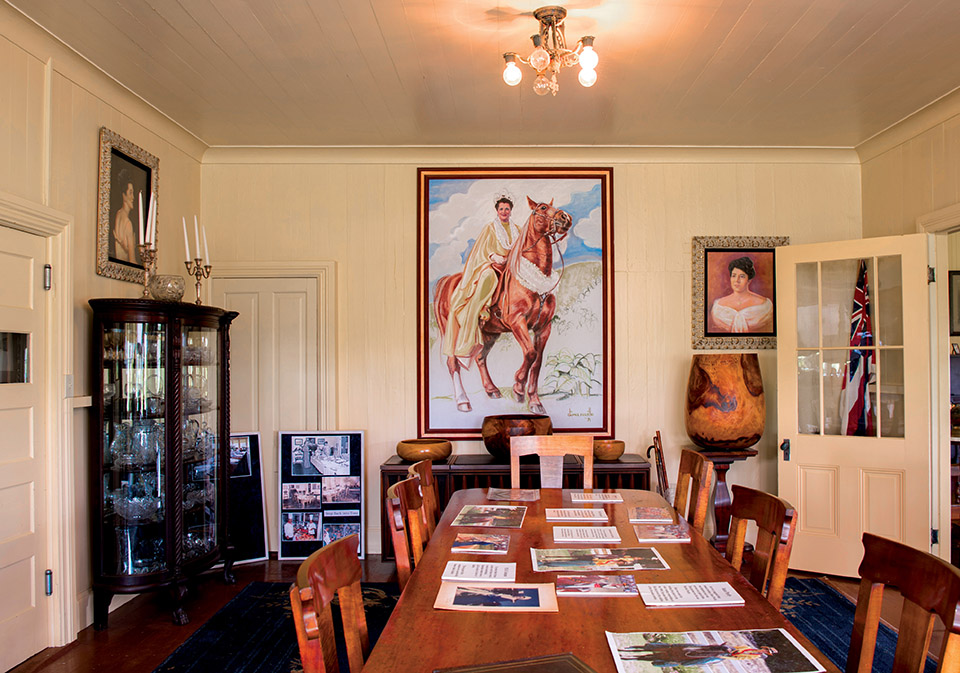
Anna
Thomas’ son, William Miller Seymour Lindsey, married a half-Hawaiian schoolteacher in 1896, Mary Leialoha Rose, and they had three children: Bill, Anna and Charles. Born in 1900 and raised on ranching life, Anna learned to rope and ride alongside her two brothers. From her mother she learned the fine arts of of pā‘ū riding, in addition to homemaking and hostessing, and proved equally adept at those.
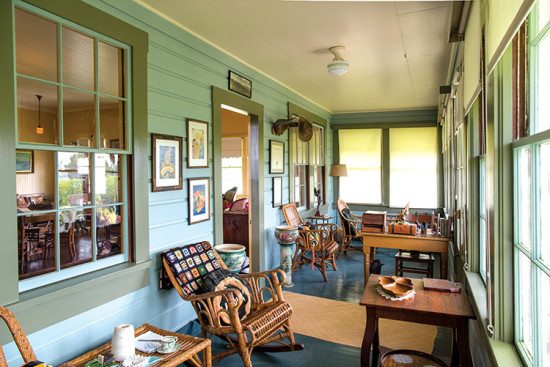
Educated on O‘ahu, where she met Queen Lili‘uokalani, Anna married Henry Lai Hipp of Hilo at the age of 19. During their 20-year marriage, she was park commissioner for Hawai‘i County, and one of her most notable projects is the celebrity tree planting along Hilo’s Banyan Drive. She also started Lai Hipp Stables, became one of Hawai‘i’s first female jockeys—training and racing her own horses—and rode in the Pasadena Tournament of Roses Parade, introducing pā‘ū riding to the world.
Meanwhile, back on the ranch, the main house—constructed between 1910 and 1914—was expanded. The side porch was enclosed and set up as William’s office, where the cowboys would pick up their pay. A large, seven-segmented bay window was added to the dining room at the front of the house, and stairs, side porch, and saddle room in the back. The barn was built with rooms for feed storage, tack, tractor, and equipment, along with a freestanding slaughterhouse and carriage house with a fuel storage shed, gardener’s room, and storeroom.
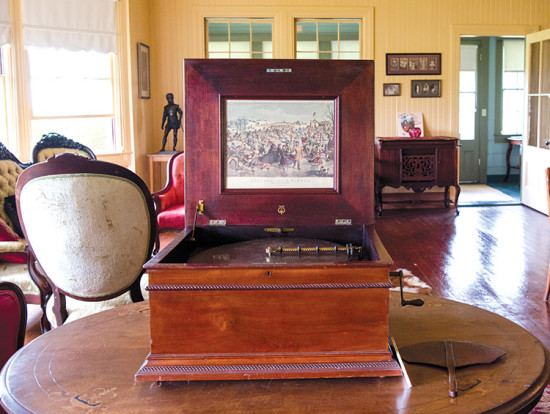
In 1939, Anna returned home to help take care of her father, and found Lindsey Ranch nearing bankruptcy as a result of his long illness. Anna took the reins. With a loan from Parker Ranch, and her own grit and determination, she got the property back on its proverbial feet and changed the name to Anna Ranch in 1941.
With one full-time ranch hand, “Bull” Awa‘a, Anna worked six days a week mending fences, branding, and buying stock. She was one of the first women in Hawai‘i to get a butcher’s license, and slaughtered her own cattle at the ranch. During WWII, she entertained officers and nurses from nearby Camp Tarawa. In the 1950s, she was the first rancher in Hawai‘i to crossbreed Brahma bulls with Hereford cattle, and first to import Charolais from France.
In 1943 she married James Lyman Perry-Fiske from North Kohala and together they saw Anna Ranch begin to prosper. Anna was able to create grand charitable events including the outdoor pageant “Old Hawai‘i on Horseback,” a fundraiser for the American Heart Association, as well as a highly successful auction for Hawai‘i Preparatory Academy. She also made significant contributions towards building the emergency room at Lucy Henriques Medical Center. In 1978, then US Congressman Daniel Akaka Sr. honored her at the Capitol.
When she died in 1995, Aunty Anna left her home to the community as a living legacy that celebrates the history and culture of ranching in Hawai‘i. With hard work by Dr. Momi Naughton and a dedicated team, Anna Ranch was named to the Hawai‘i State Register of Historic Places in 2005, and to the National Register of Historic Places in 2008.
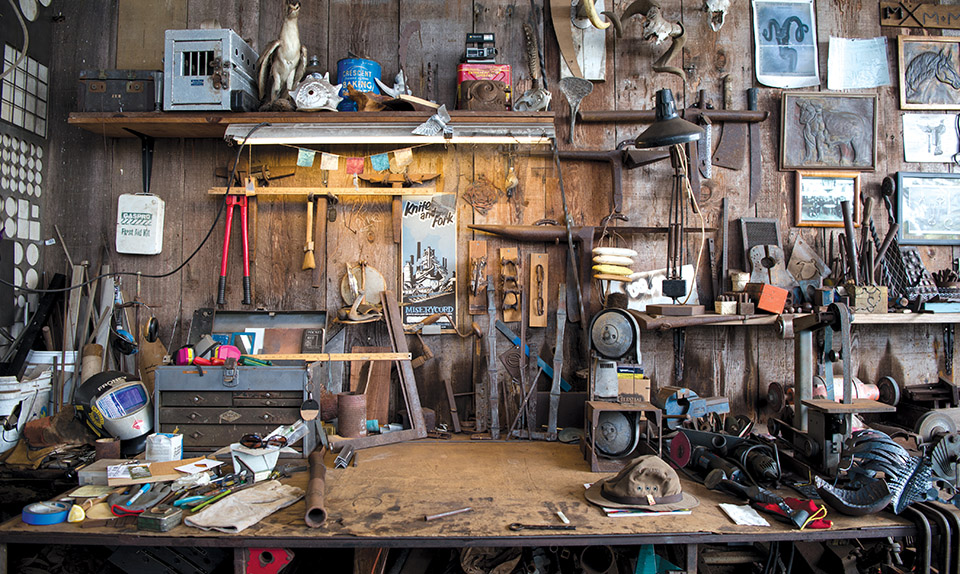
Today
The present 3.48 acre Anna Ranch Heritage Center includes the ranch house and outbuildings, and—added in 2000—a tea house, public restroom building, paved driveway and parking lot. In the gift shop, originally the kitchen, visitors can purchase Anna’s biography, Hawai‘i’s Incredible Anna, by Ruth M. Tabrah. The shop also features locally-made gifts, including hand-forged metal works by Ethan Froney, the blacksmith.
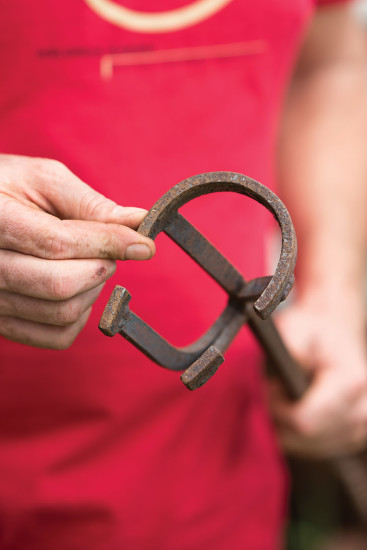
Behind the house, in the “Education Barn,” visitors may catch blacksmith Ethan working at his anvil. Ethan, who learned blacksmithing at a Seattle community college, came to the island in 2010 to do sheet metal work, and instead, was pleased to find opportunities for his blacksmith skills at Anna Ranch.
“When I got here the barn was storage, and where she parked her cattle truck,” says Ethan. “It [the cattle truck] was an old Army 6×6.” Anna’s second husband James Lyman made the ranch’s branding oven, and Ethan re-made the original Anna Ranch brand itself. “I make everything from horseshoes to hand grenades except horseshoes and hand grenades,” he says with a grin beneath his goggles.
Adjacent to the blacksmith shop is a classroom studio where artist Marcia Ray teaches painting on Tuesday and Friday afternoons at 1pm and has organized an art market, “Artisans Hui at Anna Ranch,” on Wednesdays from 9am to 2pm.
In the slaughterhouse, mountain bikes now hang on the hooks and rails that once held sides of beef. This is the base of operations for Alex Candelario of Big Island Bike Tours, who takes riders from the ranch across Kohakohau Stream and up about 1,200 feet for a snack stop, with views of the mountains and vast green Waimea hill country.
Anna Ranch Heritage Center is open Tuesday–Friday 10am to 3pm, closed major holidays and for occasional private events. When the center is open, the public is invited to enjoy self-guided tours along the Discovery Trail, with informative illustrated signs. Guided ranch house tours may be scheduled at either 10am or 1pm, with advance reservations required. Admission for guided tours is $10 adults, $5 keiki. The property is also available to rent for private functions, weddings, and social gatherings, with a variety of garden or lawn settings, as well as the tea house, Anna’s Hall. ❖
For more information: annaranch.org
Mahalo Clark Realty Corp. – Home/Building Story Sponsor
